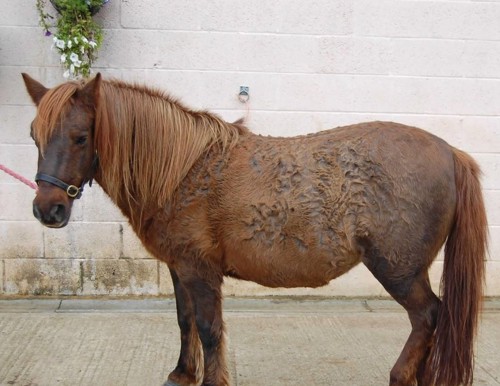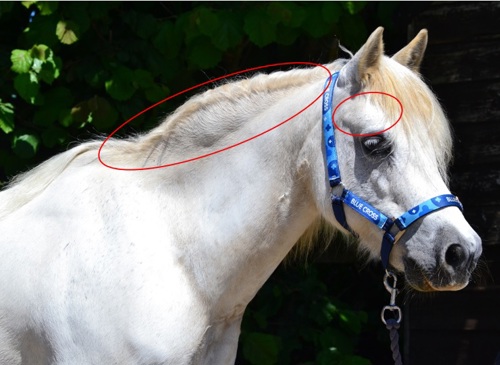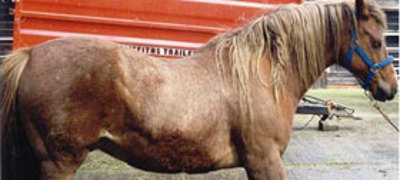PPID is caused by an imbalance in hormones produced by the pituitary gland which is located at the base of the brain. The disease often affects older horses and can develop in any breed or sex.
Donkeys can also develop PPID, for specific advice, visit The Donkey Sanctuary.

Signs
Signs can vary and some may be more obvious than others. They often include:
- Long and/or curly coat
- Inability to shed winter coat fully
- Unusual sweating (not linked to exercise or weather)
- Laminitis
- Increased water intake and urination
- Lethargy
- Weight Loss
- Abnormal fat deposits across the body
- Bulging of the hollow above the eyes
- Loss of muscle across the back and hindquarters (topline)
- Chronic infections such as sinusitis and dental disease
- Recurrent hoof abscesses
 Photo credit: The Blue Cross. Pony with thick, curly coat.
Photo credit: The Blue Cross. Pony with thick, curly coat.
Causes
PPID is a hormonal disease caused by changes to the pituitary gland, which can be found at the base of the brain. The gland is usually controlled by a substance called dopamine which helps to regulate the production of other hormones responsible for maintaining and controlling a variety of bodily functions. However, a horse with PPID can’t produce enough dopamine, resulting in dysregulation of hormones1. Adrenocorticotropic hormone (ACTH) is one of the hormones which is excessively produced with PPID2 causing the symptoms listed above.

Photo credit: The Blue Cross. Pony with unusual fatty deposits along the neck and bulging hollow above the eye.
Diagnosis
Early diagnosis of PPID in horses and ponies affected allows more time for management strategies to be used – maintaining a positive quality of life.
The initial stages of the condition are often slow to appear and can be difficult to detect, but it’s important to speak to your vet if you’re concerned about any changes in your horse. Once your vet has considered your horse’s history and clinical signs, blood samples will be taken to test for ACTH levels. This will be analysed in a laboratory, and will take a few days for the results to be confirmed. Visit the Care About Cushing’s webpage to find out more about their laboratory testing to help with diagnosis and costs.
Management
Although PPID is incurable, management strategies can be implemented, and medication may be advised to help normalise the hormone secretion and reduce the signs associated with the disease. It’s likely your vet will recommend routine blood testing to make sure the medication is effective and given at the correct dose.
Medication
chevron-down
chevron-up
Medication (Prascend) is available and can be very successful in managing the pituitary gland and hormone release3. It comes in tablet form and can be easily hidden in their feed. Once the vet has worked out the dosage for your horse, daily medication is often needed. Monitor your horse to make sure they eat the tablet. Be organised and plan ahead - make sure you order medication in enough time so that you don’t run out. A recent study found that long-term management with this method had very positive outcomes, although some horses may need to have the dose increased further into their life4.
More recently, a paste has been developed which includes the same drug used in the Prascend tablet. It’s been designed for those horses that won’t eat a small tablet and is administered orally by syringe, making it more palatable. The paste is not yet licensed in the UK. However, it can be prescribed by a vet in cases where a horse’s welfare is being negatively impacted. For example, a pony which won’t take a tablet, leading to a decline in their condition.
Once medication has been started, it’s likely this will continue for the duration of your horse’s life. This ongoing care can be a financial burden; however, not giving this to your horse can have a detrimental effect to their health. Talk to your vet for further advice and support.
Managing symptoms
chevron-down
chevron-up
To maintain a positive quality of life for your horse, symptoms will need to be managed and may include:
- Horses may need to be clipped, especially in the hotter months if they’re struggling to shed their winter coats. Appropriate rugging may then be needed if the weather turns cooler.
- Maintaining a healthy fat score to prevent laminitis
- Routine dental care
- Having a testing-led deworming plan
- Routine farriery
- Monitor your horse closely due to the increased likelihood of infection
Horses with PPID often develop insulin resistance which can be managed in a similar way to Equine Metabolic Syndrome (EMS).
Although PPID cannot be cured, horses and ponies can still have a good quality of life and remain in ridden work if managed correctly. Our Friends at the End team is here to provide support if you have concerns about your horse’s quality of life.
References
- Rice, J. (2022) Cushing’s Disease in Horses. PetMD
- Care About Cushing’s. (2023) Equine Cushing’s Disease.
- Liphook Equine Hospital. (2015) Equine Cushing’s Disease.
- Schott, H. et al., (2022) Long-Term Response of Equids with Pituitary Pars Intermedia Dysfunction to Treatment with Pergolide. Proceedings American Association of Equine Practitioners. (68) Pp. 230.



